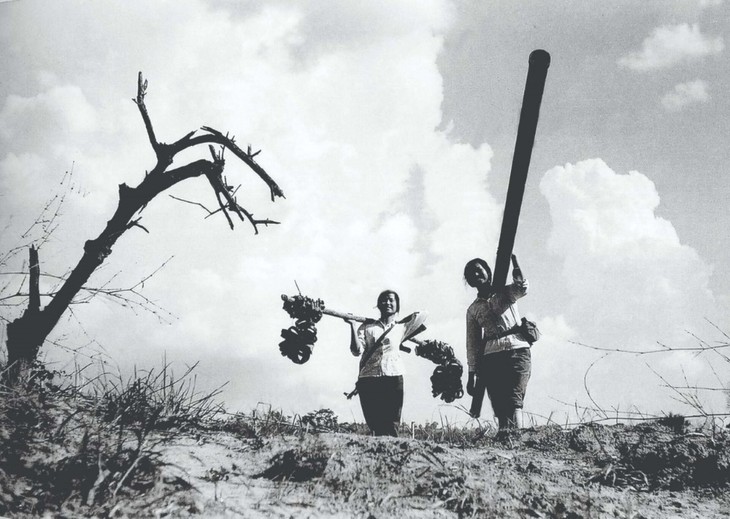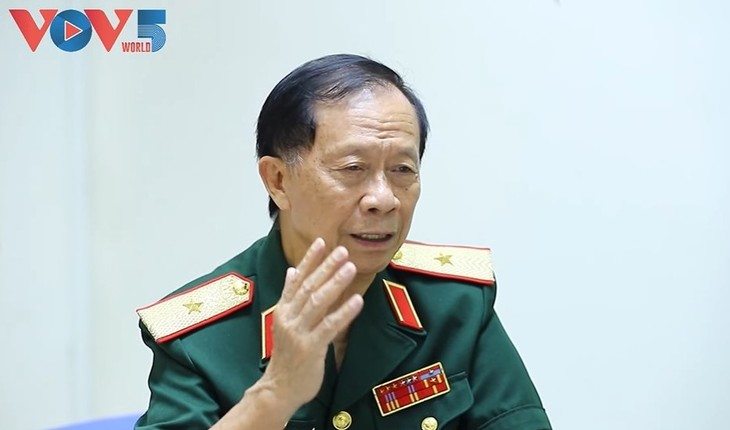(VOVWORLD) - During the national resistance war, the Truong Son trail served as a massive artery for transporting troops and supplies from the northern rear to the southern battlefield. On that extensive transportation network, a fuel pipeline system was constructed with a total length of 5,000 km from the northern mountain province of Lang Son to coastal province of Quang Ninh and to the southern province of Binh Phuoc. More than just a strategic work, the pipeline became a symbol of unyielding determination, ingenuity, and the sacrifices of the Vietnamese armyand ordinary people during wartime.
 Female soldiers of the Regiment 592 of Command 559 transport fuel pipelines in January 1972. (Archive photo) Female soldiers of the Regiment 592 of Command 559 transport fuel pipelines in January 1972. (Archive photo) |
The construction of the Truong Son pipeline began in April 1968, under the code name “Irrigation Project 01.” At that time, the 1968Uprising and Offensive by the Vietnamese soldiers and people in the south required urgent logistical support. However, shortage of fuel, a critical factor in the resistance war, had stalled the deployment of troops and essential supplies to the southern front.
Major General Ho Sy Hau, former Director of the Economic Department atthe Ministry of National Defense, is an engineer involving in designing and building the pipeline. “We tried different methods. We lined our backpacks with plastic to carry gasoline on our backs. But the plastic couldn’t withstand leaded fuelso it would rupture after just a few hours. It was inefficient and unsafe, so we couldn’t continue that way. We also carried small fuel barrels across critical, heavily bombed areas. Then we welded iron sheets to make pipes and connected them with rubber hoses, tent poles, bamboo tubes, and inner tubes from car tires. But even those materials were corroded by gasoline. These makeshift pipeline systems were found nowhere in world,” Hau said.
General Vo Nguyen Giap was the mastermind of using two sets of fuel pipelines given by the Soviet Union. The Central Military Commission later decided to use these mobile pipeline kits to transport fuel to the southern battlefield. The soldiers carried on their back thousands of pipes and tons ofmachinery, devices, and rubber tanks, crossing dense forests and rugged mountains under heavy bombardment. Colonel Nguyen Van Tao, former Deputy Head of the Pipeline Division of the Fuel Supply Corps 559, still remembers vividly the days he worked as a technical officer of Company K1, Project 18, in charge of pipeline construction in Military Zone 4.
“As we were flushing the line in preparation for fuel pumping, the enemy detected our activity. On a night in late December 1968, B-52 bombs were rained on MụGiạPass in Quang Binh province, cutting across the pipeline. The following days saw more B-52 bombings and airstrikes on the 050 site, a key target on Mu Gia Pass. The rock mountains were peeled off and crumbled into dust. Military engineers had to blast trenches for soldiers to reconnect the pipeline, but they were constantly destroyed by bombings,” Tao said.
 Major General Ho Sy Hau, former Director of the Economic Department at the Ministry of National Defense (Photo: VOV) Major General Ho Sy Hau, former Director of the Economic Department at the Ministry of National Defense (Photo: VOV) |
The Truong Son fuel pipeline became a fierce battlefield between the engineering force of the Vietnam People’s Army and the enemy’s powerful air force and advanced weaponry.
Major General Ho Sy Hau recalled, “The enemy always bombed the lowest points. So, we made a bold move. We brought the pipeline up to the highest places, where they’d least expect. It was a daring solution, requiring us to calculate risky formulas that were never taught in textbooks but adaptive to Truong Son’s difficult terrain. Finally, we routed the pipeline to the mountain top at an elevation of over 900 meters. On December 22, 1969, fuel flew over 50 km from the eastern base of the Truong Son range to the western side in Ban Cop of Laos.”
By March 1975, the Truong Son soldiers had built a complete pipeline system from the eastern to the western flank of Truong Son, with 316 pump stations and 101 storage depots with a total capacity of over 300,000 cubic meters. The network’s multiple branches totaling 5,000 kilometers startedin Lang Son province and Mong Cai in Quang Ninh province, flowing to Hanoi, then Quang Binh in the central region, and Binh Phuoc in the south.
Surviving relentless attacks from the enemy, the fuel pipeline accomplished its mission of delivering 5.5 million cubic meters of fuel to the southfrom 1968 to 1975. It played a vital role in the 1975 Spring Offensive toward the liberation of the south and national reunification. Lieutenant General Dong Sy Nguyen, Commander of Corps 559, once said that “If the Truong Son trail is legendary, then the fuel pipeline is the legend within that legend.”